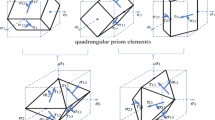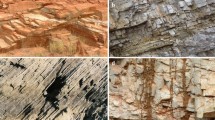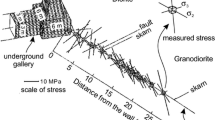Conclusions
-
1.
The static Poisson ratios of rocks increase with the pressure both under simple and under hydrostatic compression. The harder the rock, the less does the Poisson ratio μ depend on the load.
-
2.
Increased moisture content increases the static Poisson ratio. The greater the moisture content, the greater is the influence of load on the Poisson ratio. The dynamic Poisson ratio is very much less sensitive to moisture than the static one.
-
3.
Both under simple and hydrostatic compression, the dynamic Poisson ratio has a high value which agrees with the results of static tests at very high pressures.
Similar content being viewed by others
Literature Cited
L. S. Burshtein, “Tension-compression diagrams of sandstones,” Fiz.-Tekh. Probl. Razrabotki Polezn. Iskop., No. 1 (1967).
G. N. Kuznetsov, The Mechanical Properties of Rocks [in Russian], Ugletekhizdat, Moscow (1947).
Yu. V. Riznichenko, Trudy Geofizicheskogo instituta Akad. Nauk SSSR, No. 34, Izd. AN SSSR, Moscow (1956).
C. Oliphant, “Comparison of field and laboratory measurements,” Bull. Geol. Soc. America, No. 61 (1950).
L. S. Burshtein, “The dynamic modulus of elasticity of certain rocks,” Zapiski LGI, No. 1, izd. LGI, Leningrad (1966).
V. V. Zhadin, Geologiya i Geofizika, No. 3 (1960).
V. V. Zhadin, in: Questions of the Dynamic Theory of the Propagation of Seismic Waves [in Russian], No. 2, izd. LGU, Leningrad (1959).
E. Müller, Experimente über Wellenausbreitung in Gesteinproben, Geol. Jahrb., No. 70 (1954).
H. Link, Zur Querdehnungszahl won Gestein, Geol. und Bauwessen, Heft. 2 (1962).
G. Everling, Gesteinmechanische untersuchungen, Glückauf, No. 7 (1960).
T. Horibe and R. Kobayaschi, Physikalische und Mechanische Eigenschaften von Karbongestein, Intern. Kongr. Paris (1960).
D. Hughes and H. Jones, Variation of Elastic Moduli of Rocks, Bull. Geol. Soc. America, No. 61 (1950).
Author information
Authors and Affiliations
Additional information
Translated from Fiziko-Tekhnicheskie Problemy Razrabotki Poleznykh Iskopaemykh, No. 3, pp. 35–39, May–June, 1968.
Rights and permissions
About this article
Cite this article
Burshtein, L.S. Determination of poisson's ratio for rocks by static and dynamic methods. Soviet Mining Science 4, 235–238 (1968). https://doi.org/10.1007/BF02501543
Received:
Published:
Issue Date:
DOI: https://doi.org/10.1007/BF02501543




